The Influence of Different Pre-Treatments of Concrete Surface on the Bond Strength of Geopolymer-Type Coating Layer
Abstract
:1. Introduction
- the type/properties of coating material,
- the condition of the substrate, depending on its treatment (concrete surface preparation),
- way/technique of coating application.
- Concrete surfaces are often very rough and have partly open air voids.
- Concrete surfaces are adsorbent to varying degrees.
- Concrete surfaces may be dusty and friable.
- Formed and floated surfaces commonly have a thin and relatively weak layer (laitance).
- Formed surfaces can contain significant amounts of adhered release agent.
2. Materials and Methods
- Original fly ash: OT-FA (coming from Heating plant, class F) and
- Ground fly ash: GT-FA—as a basic component of geopolymer,
- ground granulated blast furnace slag: GGBFS (Steel making factory, Slovakia)—as an intensificator,
- Na2SiO3 + NaOH—as an activator,
- washing-aggregate sludge: WAS—the material from processing (washing) the crushed aggregates, obtained from an Eastern Slovakia producer of crushed aggregates. After the separation of portion, <125 μm was applied as microfiller.
- ordinary Portland Cement—OPC (CEM I 42.5 R, Slovakia)—as a binder
- tap water,
- admixture—the plasticizer to improve the consistency of mixtures.
- brushing (B) with a wire brush: the purpose of this process was to roughen the surface.
- pressure washing (PW): the aim was to remove the thin layer of cement milk and roughen the surface. The pressure washer was used for this purpose.
- pressure washing followed by penetration (PW + P): standard acrylate type penetrator.
- non-treated surface (0)—it was used as a reference surface.
3. Results and Discussion
3.1. Results According to Technique of Surface Treatment
- Surface 0: T2, T1, T3.
- Surface B: T3, T1, T2.
- Surface PW: T3, T2, T1.
- Surface PW-P: T3, T2, T1.
3.2. Results According to the Type of Coating Material
- Coating material T1 shows good performance as far as it is used on the PW-P surface. Here, the balanced values of adhesive strength were measured on time (2.0 N/mm2). Once other surfaces are used, the values decrease after 28 days. The 28-day values between 1.4 and 2.2 N/mm2 were achieved.
- Coating material T2 gives quite a balanced performance on all surfaces; however, it is the best on the PW-P surface. The 28-day values between 1.6 and 2.6 N/mm2 were achieved.
- Coating material T3 shows the best performance when PW and PW-P surfaces are used—the adhesive strength is 2.8 N/mm2 and 2.7 N/mm2, respectively.
- Coating material T4 shows the most significant increase in values from 2 to 28 days. The values in 28 days are balanced, ranging between 2.2 and 2.9 N/mm2. This material shows the best performance when used on the PW surface.
- Coating material T5 shows the lowest values of all samples. This material shows the best performance when used on the B surface; however, the range of results (not exceeding the 1.0 N/mm2 at any given time, as well as on any surface) allows for concluding that the kind of surface treatment does not provide for significant differences in adhesive strength. This is in line with [26], who showed that increasing the contact area in the substrate, as a result of different surface textures, does not always increase the bonding strength between the substrate and the render. The results of T5 do not provide a basis for practical use.
4. Conclusions
- All tested surfaces enabled the achievement of the 28-day values of adhesive strength between 2.0–3.0 N/mm2, which fulfill the usual limit (1.5 N/mm2 minimum). However, when using both the untreated and brushed surface, one kind of coating material can possibly be used (the T4 mixture).
- The pressure-wash treated surfaces (PW and PW-P) were more universal; they allowed almost all geopolymer mixtures (T1–T4) to reach values above 2.0 N/mm2
- Geopolymer-based mixtures achieved better adhesive strength than that of cement-based mixture, regardless of surface treatment technique. Among them, sample T4 reached the best values (in three out of four cases of pre-treated surfaces); thus, the addition of sludge microfiller seems to be beneficial for improving the adhesive strength of geopolymer-type coating material.
- For the best performance, the appropriate kind of mixture (coating material) has to be assigned to the particular surface pre-treatment technique.
- Time development of adhesive strength showed increasing tendency for all surfaces, as well as coating materials, but mostly only up to 7 and 28 days, respectively; then, the decrease was detected. On the basis of a few exceptions that have been observed, it is possible to specify T2 material to be the best for all treated surfaces in terms of maintaining the increasing time development of adhesive strength.
Funding
Conflicts of Interest
References
- Balaguru, P.N. Geopolymer Coating Demonstration Project for Route I-295 Scenic Overlook. In Report, Center for Advanced Infrastructure & Transportation (CAIT); The State University: Rutgers, NJ, USA, 2006. [Google Scholar]
- Thokchom, S.; Dutta, D.; Ghosh, S. Effect of Incorporating Silica Fume in Fly Ash Geopolymers. World Acad. Sci. Eng. Technol. 2011, 60, 243–247. [Google Scholar]
- Zongjin, L.; Zhu, D.; Yunsheng, Z. Development of Sustainable Cementitious Materials. In Proceedings of the International Workshop on Sustainable Development and Concrete Technology, Beijing, China, 20–21 May 2004; Iowa State University: Ames, IA, USA, 2004. [Google Scholar]
- Kong, D.L.Y.; Sanjayan, J.G. Effect of elevated Effect of elevated temperatures on geopolymer paste, mortar and concrete. Cem. Concr. Res. 2010, 40, 334–339. [Google Scholar] [CrossRef]
- Cresswell, D. Quarry Fines & Paper Sludge in Manufactured Aggregate. In Case Study WRT 177/WR0115; Smart Waste: London, UK, 2016. [Google Scholar]
- Salwa, M.S.; Al Bakri, A.M.; Kamarudin, H.; Ruzaidi, C.M.; Binhussain, M.; Zaliha, S.S. Review on Current Geopolymer as a Coating Material. Aust. J. Basic Appl. Sci. 2013, 7, 246–257. [Google Scholar]
- Temuujin, J.; Minjigmaa, A.; Rickard, W.; Lee, M.; Williams, I.; Van Riessen, A. Preparation of Metakaolin Based Geopolymer Coatings on Metal Substrates as Thermal Barriers. Appl. Clay Sci. 2009, 46, 265–270. [Google Scholar] [CrossRef]
- Temuujin, J.; Minjigmaa, A.; Rickard, W.; Lee, M.; Williams, I.; Van Riessen, A. Fly Ash Based Geopolymer Thin Coatings on Metal Substrates and Its Thermal Evaluation. J. Hazard. Mater. 2010, 180, 748–752. [Google Scholar] [CrossRef] [PubMed]
- Balaguru, P.N.; Nazier, M.; Arafa, M. Field Implementation of Geopolymer Coatings. In Report, Center for Advanced Infrastructure & Transportation (CAIT); The State University: Rutgers, NJ, USA, 2004. [Google Scholar]
- Guide to Selecting Protective Treatments for Concrete; 515.2R-13; American Concrete Institute: Farmington Hills, MI, USA, 2013.
- Benn, B.T. The Influence of Curing and Surface Preparation on the Adhesion of Protective Coatings on Concrete. In The Research Report, Faculty of Engineering and the Built Environment; University of the Witwatersrand: Johannesburg, South Africa, 2008. [Google Scholar]
- Mailvaganam, N.P.; Pye, G.B.; Arnott, M.R. Surface Preparation of the Concrete Substrate. In Construction Technology Updates; Institute for research in construction, National Research Council of Canada: Ottawa, ON, Canada, 1998. [Google Scholar]
- Želinková, M. The Analysis of Particle Size of Fly Ashes—The Possibility of Obtaining Fine Particles by Grinding. In Proceedings of the Ph.D. Students Seminar, Tromsø, Norway, 13–15 October 2014; TU Kosice: Košice, Slovakia, 2014. [Google Scholar]
- Palomo, A.; Grutzeck, M.W.; Blanco, M.T. Alkali-activated fly ashes -Cement for the future. Cem. Concr. Res. 1999, 29, 1323–1329. [Google Scholar] [CrossRef]
- Palomo, A.; Fernández-Jiménez, A. Alkaline Activation, Procedure for Transforming Fly Ash into New Materials. In Proceedings of the World of Coal Ash (WOCA) Conference, Denver, CO, USA, 9–12 May 2011. [Google Scholar]
- Yazici, S.; Arel, S. Effects of fly ash fineness on the mechanical properties of concrete. Sadhana 2012, 37, 389–403. [Google Scholar] [CrossRef]
- Škvara, F.; Jílek, T.; Kopecký, L. Geopolymer materials based on fly ash. Ceram. Silic. 2005, 49, 195–204. [Google Scholar]
- Sičáková, A.; Števulová, N. Basic physical-mechanical properties of geopolymers depending on the content of ground fly ash and fines of sludge. Sel. Sci. Pap. J. Civ. Eng. 2017, 12, 85–96. [Google Scholar] [CrossRef]
- European Committee for Standardization. EN 1542 Products and Systems for the Protection and Repair of Concrete Structures. Test Methods. Measurement of Bond Strength by Pull-of; European Committee for Standardization: Brussels, Belgium, 2001. [Google Scholar]
- European Committee for Standardization. 1504–2 Products and Systems for the Protection and Repair of Concrete Structures. Definitions, Requirements, Quality Control and Evaluation of Conformity. Part 2: Surface Protection Systems for Concrete; European Committee for Standardization: Brussels, Belgium, 2005. [Google Scholar]
- O’Dea, V.; Schwab, R. Preparing Cementitious Mortars to Support High-Performance Lining Systems. Broom Finish or Blasted Surface; PACE: New Orleans, LA, USA, 2009. [Google Scholar]
- Fiebrich, M.H. Scientific Aspects of Adhesion Phenomena in the Interface Mineral Substrate-Polymers. In Proceedings of the 2nd Bolomey Workshop Adherence of young and old Concrete, Sitten, Switzerland, 1 April 1994; Aedificatio Verlag: Unterengstringen, Switzerland, 1994. [Google Scholar]
- Papakonstantinou, C.G.; Balaguru, P.N. Geopolymer Protective Coatings for Concrete. In Proceedings of the International SAMPE Symposium and Exhibition, Baltimore, MD, USA, 3–7 June 2007; Volume 52. [Google Scholar]
- Firdaus; Yunus, I.; Rosidawani. Contribution of Fineness Level of Fly Ash to the Compressive Strength of Geopolymer Mortar. MATEC Web Conf. 2017, 103, 01026. [Google Scholar] [CrossRef] [Green Version]
- Nugteren, H.W.; Butselaar-Orthlieb, V.C.; Izquierdo, M.; Witkamp, G.J.; Kreutzer, M.T. High Strength Geopolymers from Fractionated and Pulverized Fly Ash. In Proceedings of the World of Coal Ash Conference, Lexington, KY, USA, 4–7 May 2009. [Google Scholar]
- Stolz, C.M.; Masuero, A.B.; Pagnussat, D.T.; Kirchheim, A.P. Influence of substrate texture on the tensile and shear bond strength of rendering mortars. Constr. Build. Mater. 2016, 128, 298–307. [Google Scholar] [CrossRef]
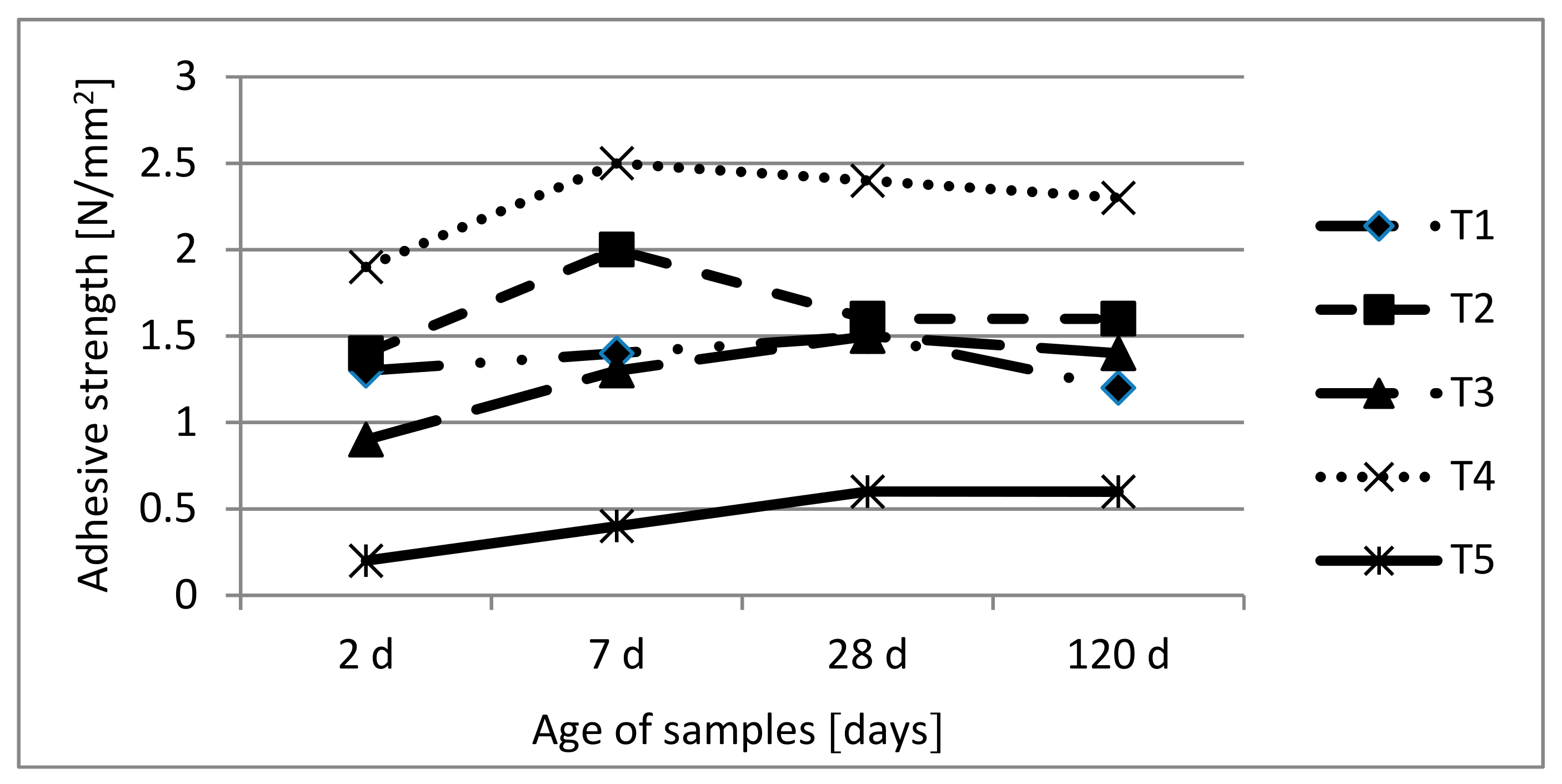
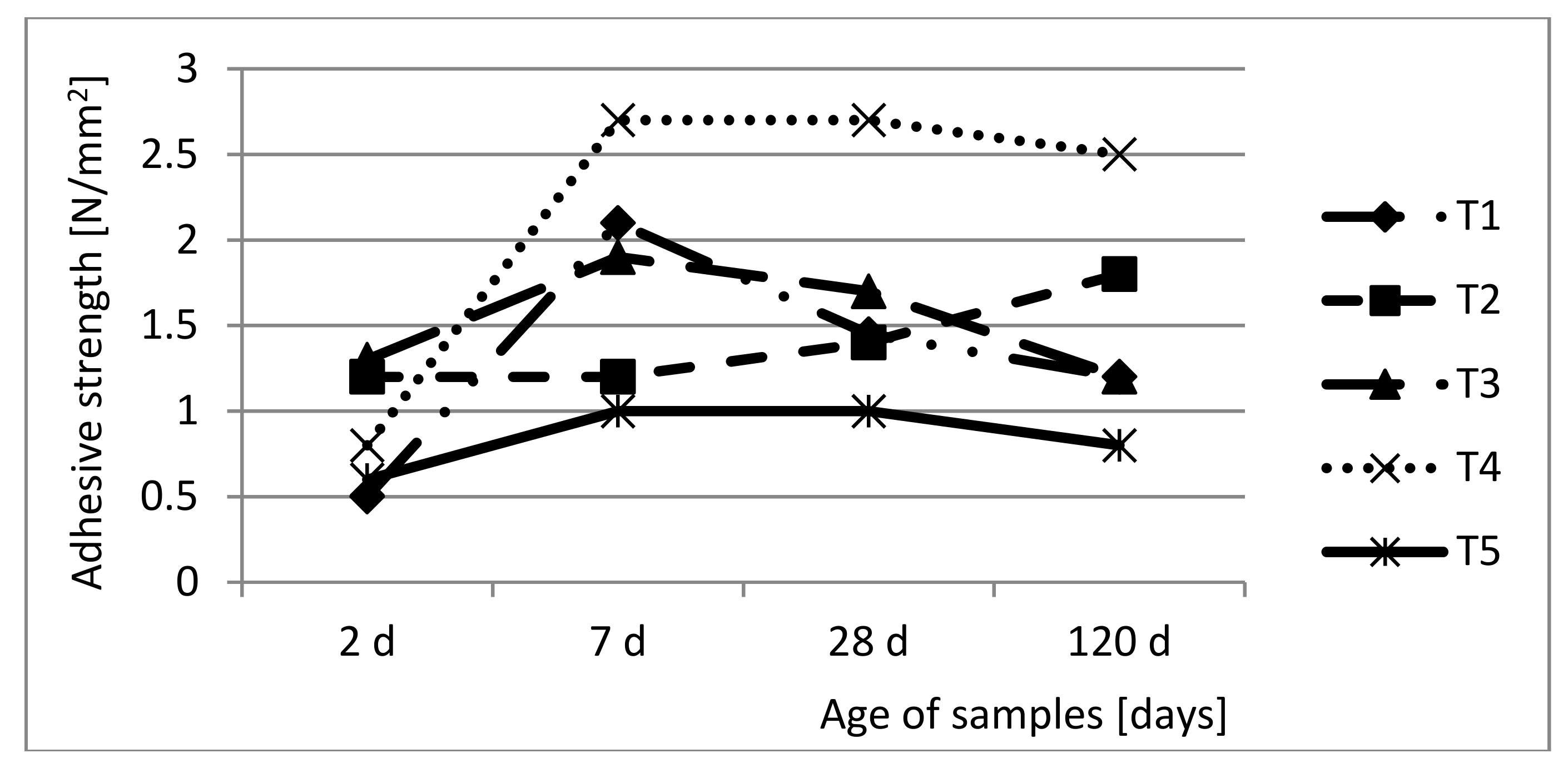
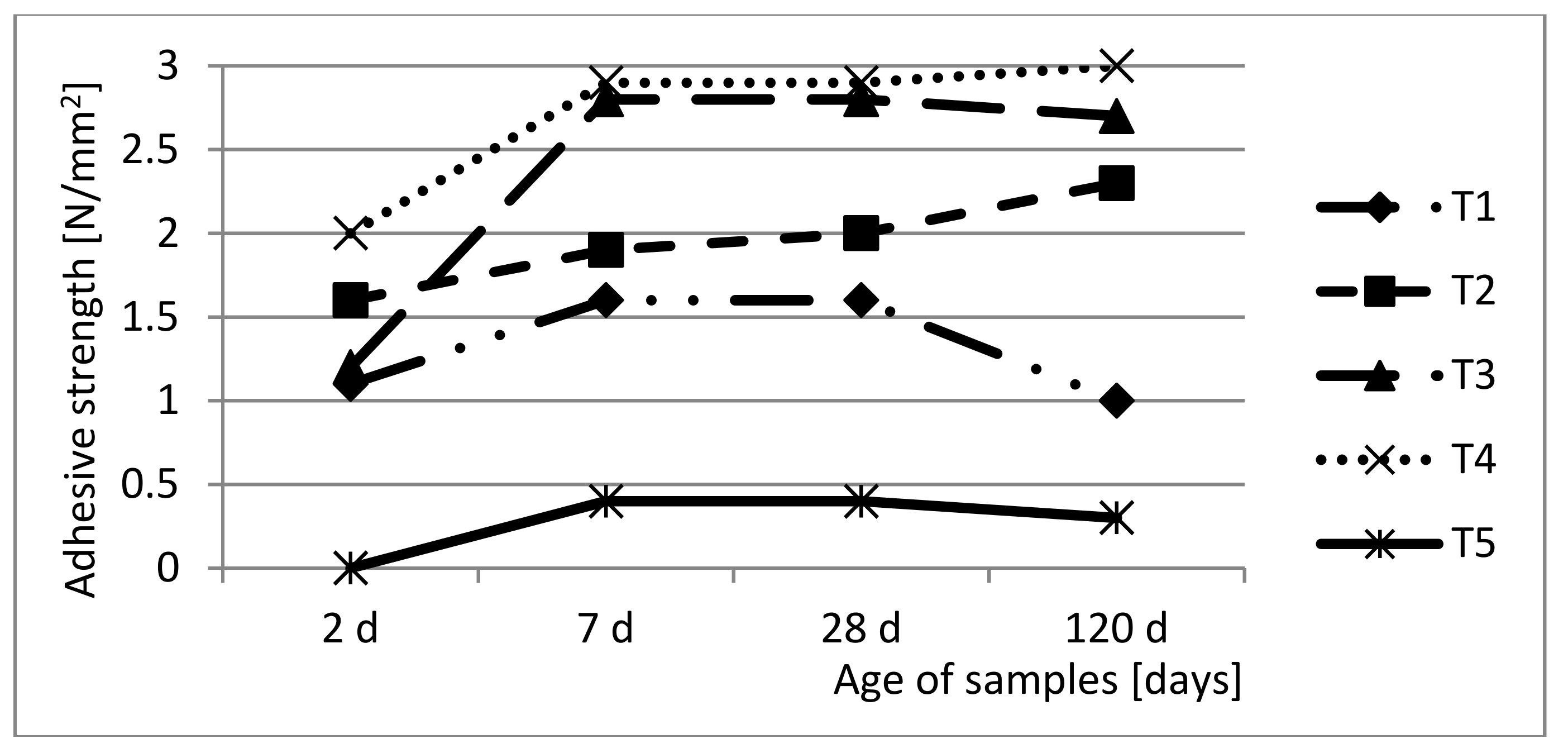

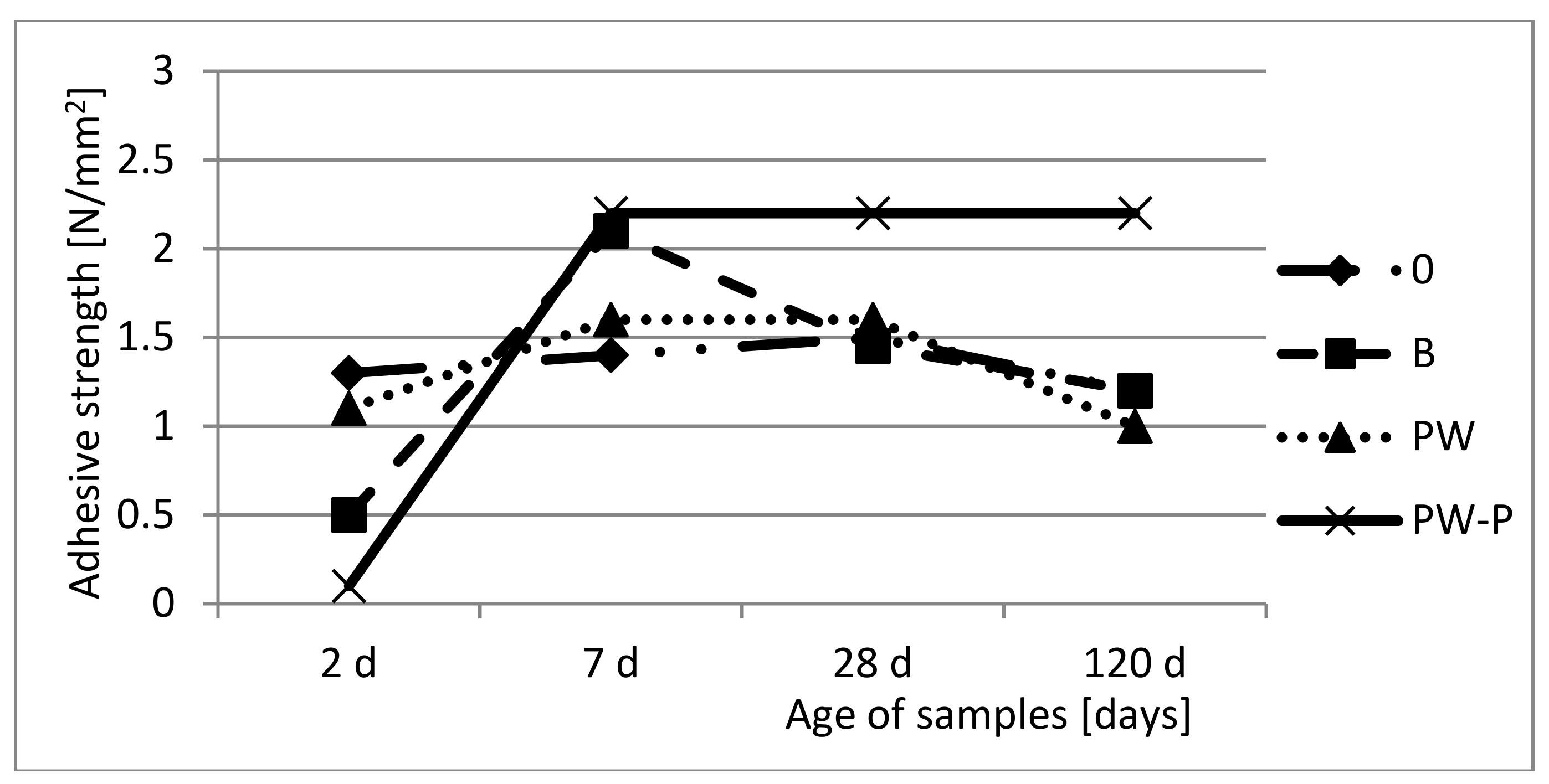

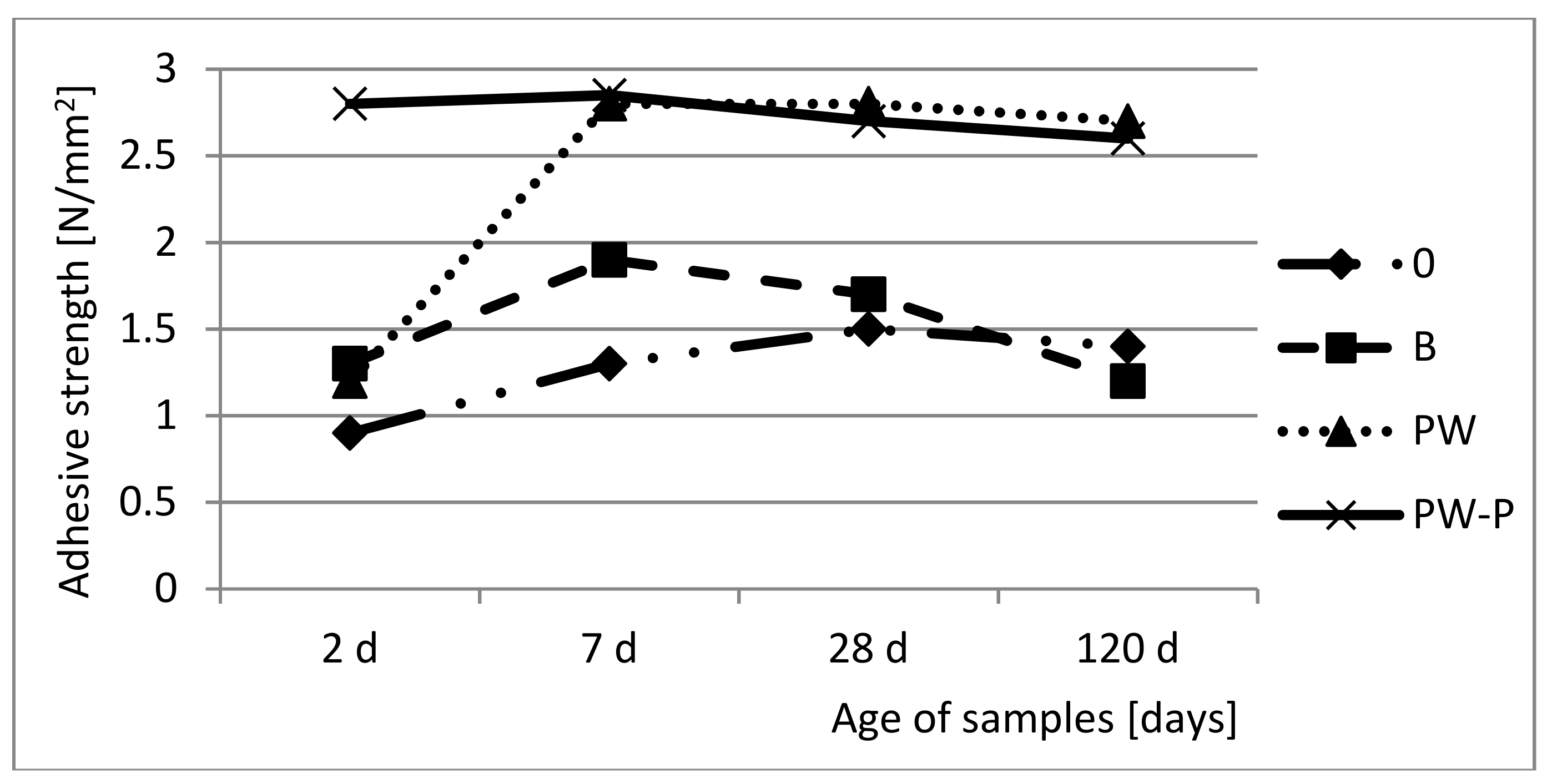

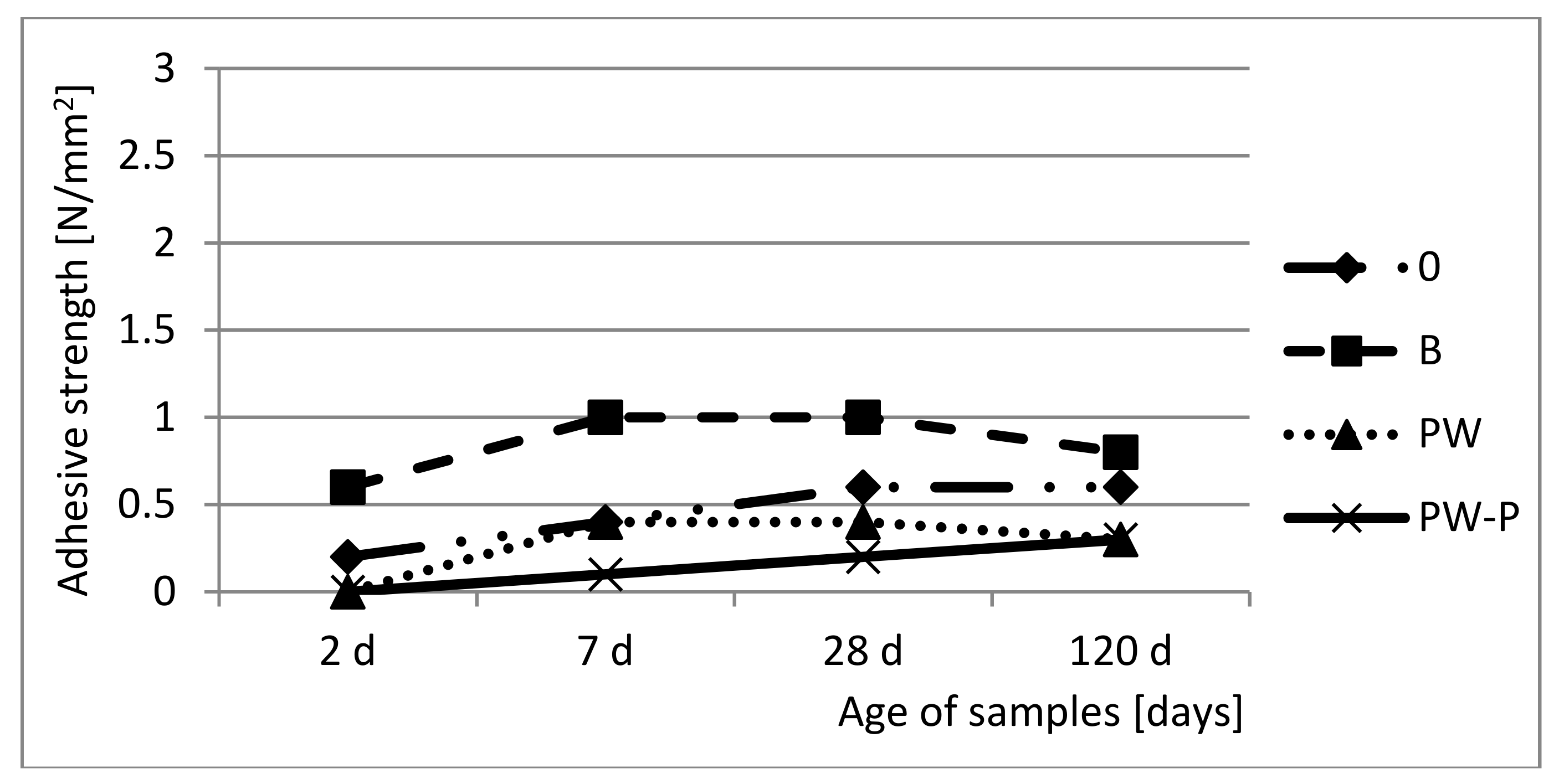
| Materials | Oxide Composition (%) | Parameters of Grain Size Distribution (μm) | |||||||
|---|---|---|---|---|---|---|---|---|---|
| SiO2 | CaO | MgO | Fe2O3 | Al2O3 | d(0.1) | d(0.5) | d(0.9) | dm | |
| OT-FA | 51.11 | 2.58 | 1.18 | 6.40 | 23.21 | 3.97 | 20.44 | 84.73 | 74.10 |
| GT-FA | 49.72 | 2.49 | 1.09 | 6.37 | 22.32 | 3.48 | 14.53 | 52.81 | 31.02 |
| GGBFS | 41.28 | 35.98 | 12.85 | 0.39 | 6.30 | 3.61 | 19.03 | 111.5 | 49.46 |
| OPC | 19.87 | 64.36 | 4.61 | 3.18 | 3.99 | 3.20 | 17.69 | 49.57 | 29.90 |
| WAS < 125 μm | 42.66 | 5.83 | 5.04 | 6.54 | 11.19 | 17.49 | 82.50 | 149.8 | 83.55 |
| Materials | Mixtures | |||||
|---|---|---|---|---|---|---|
| T1 | T2 | T3 | T4 | T5 | ||
| Composition of fillers (%) | GT-FA | 100 | 50 | - | 70 | 70 |
| OT-FA | - | 50 | 100 | - | - | |
| WAS < 125 μm | - | - | - | 30 | 30 | |
| Indication of presence of other components (•) | GGBFS (20% of FA) | • | • | • | • | - |
| Na2SiO3 | • | • | • | • | - | |
| 8M NaOH | • | • | • | • | - | |
| OPC | - | - | - | - | • | |
| Water | • | • | • | • | • | |
| Plasticizer | • | • | • | • | • | |
| Parameters | Values of Parameters | ||||||
|---|---|---|---|---|---|---|---|
| According to References | Tested Mixtures | ||||||
| T1 | T2 | T3 | T4 | T5 | |||
| 1 | Water from the alkaline activators/geopolymer solids | 0.19 | 0.19 | 0.19 | 0.19 | 0.25 | / |
| 2 | Alkaline solution/FA | 0.25–0.45 | 0.38 | 0.38 | 0.38 | 0.56 | / |
| 3 | Na2SiO3/NaOH | 1–1.25 | 1.18 | 1.18 | 1.18 | 1.18 | / |
| 4 | Water/solids | 0.23–0.51 | 0.24 | 0.26 | 0.30 | 0.33 | 0.37 |
© 2018 by the author. Licensee MDPI, Basel, Switzerland. This article is an open access article distributed under the terms and conditions of the Creative Commons Attribution (CC BY) license (http://creativecommons.org/licenses/by/4.0/).
Share and Cite
Sicakova, A. The Influence of Different Pre-Treatments of Concrete Surface on the Bond Strength of Geopolymer-Type Coating Layer. Sustainability 2018, 10, 4053. https://doi.org/10.3390/su10114053
Sicakova A. The Influence of Different Pre-Treatments of Concrete Surface on the Bond Strength of Geopolymer-Type Coating Layer. Sustainability. 2018; 10(11):4053. https://doi.org/10.3390/su10114053
Chicago/Turabian StyleSicakova, Alena. 2018. "The Influence of Different Pre-Treatments of Concrete Surface on the Bond Strength of Geopolymer-Type Coating Layer" Sustainability 10, no. 11: 4053. https://doi.org/10.3390/su10114053





